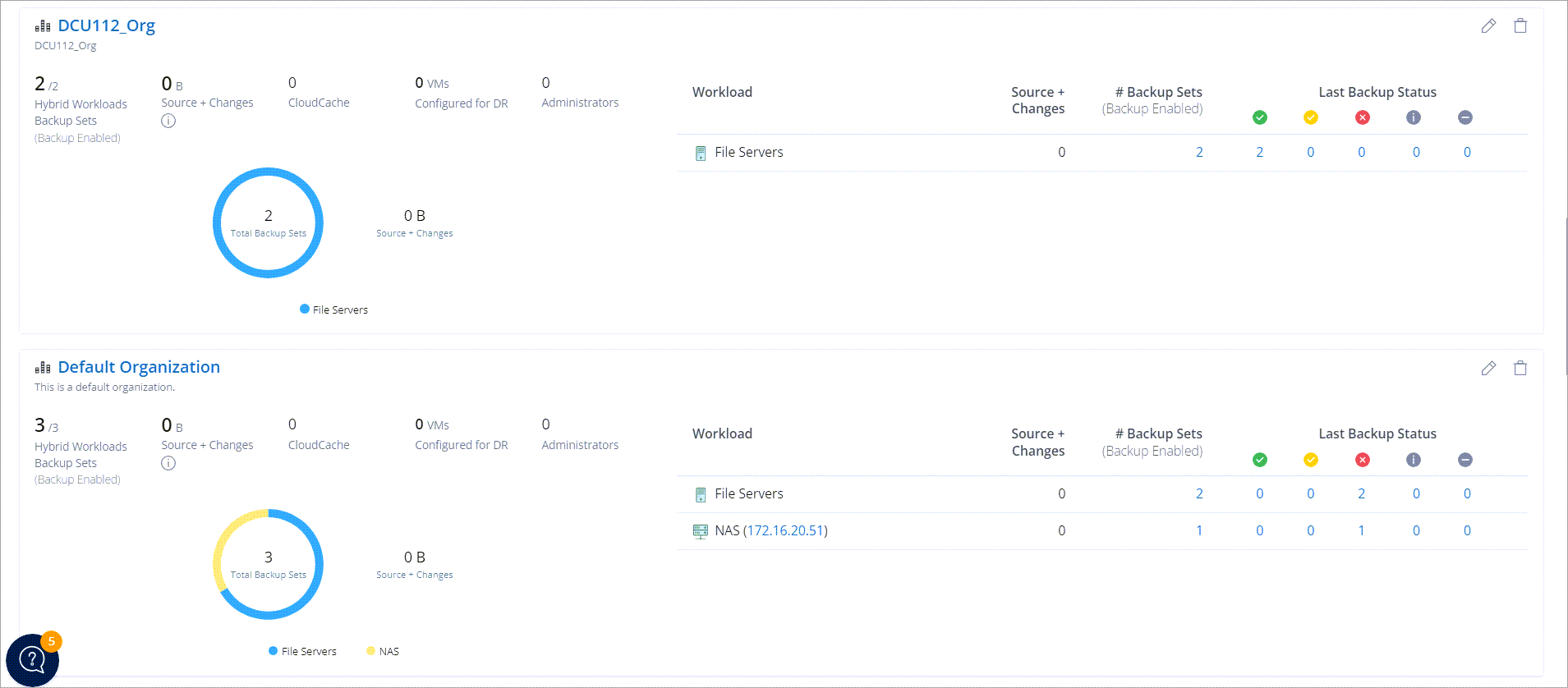All Organizations
Overview
The All Organizations page displays organizations you have configured with the Druva setup. It also provides a brief overview of the workloads configured for backup within these organizations. By default, Druva configures one organization named Default Organization.
To View the All Organizations page
-
Log in to the Hybrid Workloads Management Console.
- If the organization is enabled, click All Organizations on the top navigation pane. The All Organizations page is displayed. For more information, see Enable or Disable Organizations.
All Organizations Page

The All Organization page displays the Last Updated timestamp that shows when the page was last updated. You can locate any configured organization from the All Organizations list using the Search bar. You also have the option to create new organizations and disable, edit, or delete existing ones.
Note: The Backup Set Distribution (number of backup sets per workload) and the Source + Changes Distribution are refreshed every 24 hours.
Additionally, the All Organizations page displays the list of the configured organizations along with the relevant details for each organization that is explained as follows:
- Hybrid Workloads Backup Sets
Displays the count of backup-enabled backup sets in comparison to the total configured backup sets. The Backup Sets Distribution pie chart displays the distribution of configured backup sets across the workloads. Hover over the pie chart to get the distribution count of backup sets. Clicking on the backup set count redirects you to the details page, displaying configured backup sets with backups enabled. - Azure VMs
Displays the total number of VMs with backups enabled in comparison to the total configured VMs. The Azure VMs Distribution chart displays the total number of VMs that are configured for backup. Hover over the pie chart to get the detailed distribution of Azure VMs. - Source + Changes
Displays the amount of backup data generated at the source, including Source + Changes, for all workload types and both backup-enabled and backup-disabled backup sets. The Source + Changes Distribution pie chart displays Source + Changes data distribution by workloads. Hover over the pie chart to get the detailed distribution. - CloudCache
Displays the count of configured CloudCache devices for the selected organization. Clicking on the CloudCache count redirects to the Configured tab on the All CloudCache Devices page. - Configured for DR
Displays the number of virtual machines configured for Disaster Recovery for the selected organization. - Administrators
Displays the total number of administrators (Organization and Group Administrators) configured with the selected organization. Clicking on the count navigates you to the Manage Administrators page, which displays the list of administrators along with their relevant details such as names, roles, and email addresses. - Workloads configured for backup
This section lists the workloads along with the relevant details such as the number of Backup-enabled Backup sets, Source + Changes, and Last Backup Status, which is further categorized by Backup Successful, Backup With Errors, Backup Failed, Backup Window Expired, Never Backed Up.
Click the number against a specific status to view backup information on the associated workload page.
Adding a New Organization
You can create a new organization by following the below steps:
-
Log in to the Enterprise Workloads Management Console
-
In the top right corner, click New Organization and enter the following details:
-
Name
-
Description (Optional)
-
-
Click Create
Note: You can click on Learn More that redirects you to the Multi-organization administration page
Editing an Organization Details
You can edit the organization details by following the below steps:
-
Log in to the Enterprise Workloads Management Console.
-
Click the Edit icon for the organization that you want to rename.
- In the Edit Organization dialog box, enter the new name and description of the organization, and click Save.
Deleting an Organization
You can delete an organization by following the below steps:
-
Log in to the Enterprise Workloads Management Console.
-
Click the Delete icon for the organization that you want to delete.
- In the Confirmation dialog box, click Yes.

